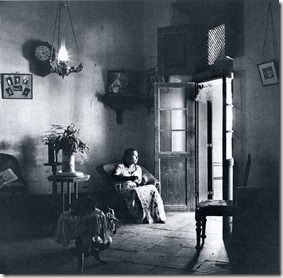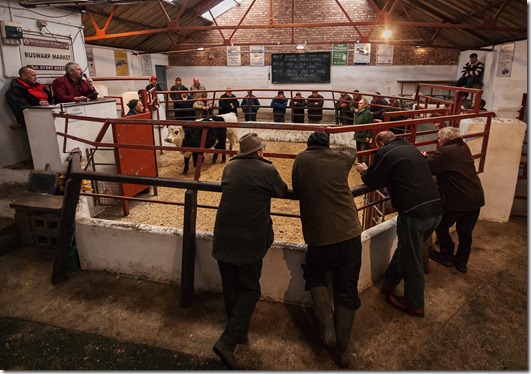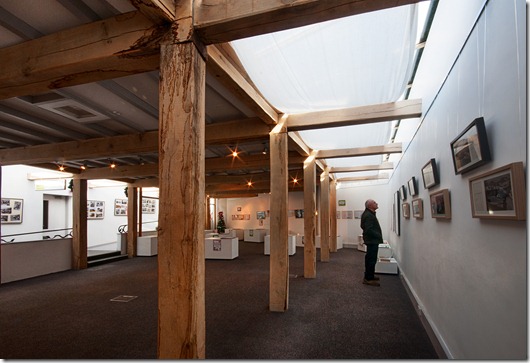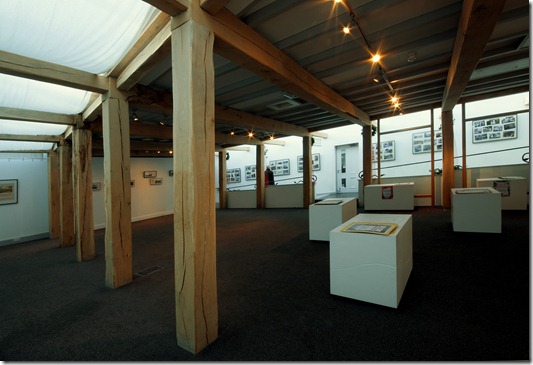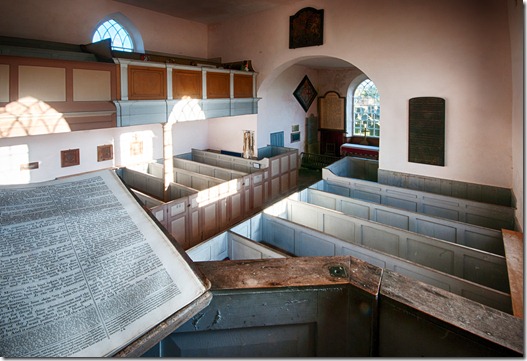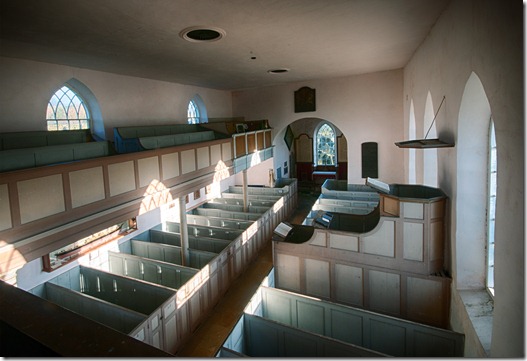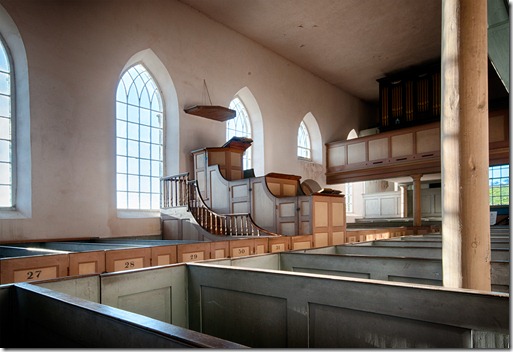People and Place
Saturday 29 December 2012
Project: Space and light
The high contrast is obtained due to the bright light from the door which creates dark shadows in parts of the room.
Light from a smaller window could create a chiaroscuro effect which causes even greater contrast – see Michael Freeman’s ‘The Complete Guide to Light and Lighting in Digital Photography’. Here he states that the degree of contrast used in an image depends on three things:
· The amount of detail required in the shadows.
· The graphic design of the image.
· The atmosphere of the image
So using the light available at different times of day can change any of these three factors. Also the use of artificial light would affect the contrast.
The section ‘Lighting Spaces’ in the book is useful in describing what should be considered when making a lighting plan. The plan will usually involve different light sources. These could be from existing tungsten or fluorescent lighting, additional photographic lighting, flash, reflectors etc. as well as natural light from windows / doors. Obviously, before making a plan, the space needs to be assessed and the amount of contrast required.
Norman McGrath echoes the requirements for the lighting plan in ‘Photographing Buildings Inside and Out’ and emphasizes that the existing lighting should be assessed on a preliminary visit – it may be necessary to replace inoperative lamps or mismatched fluorescent tubes. Window blinds and / or curtains should be checked. He considers the types of available light:
Daylight changes throughout the day, not only with direction, but also intensity. Direct sunlight entering a space may or may not be welcome, depending on the type of image required, so the shoot may have to be rescheduled to suit the type of daylight.
This could be an area where HDR imagery would be used usefully, but for the sake of the exercise I won’t consider it.
Tuesday 4 December 2012
Exercise 3.02 – The user’s viewpoint
This exercise will be a little more difficult to progress. Looking for spaces where particular activities are undertaken isn’t difficult, but I think that gaining permission to take photographs may be more difficult.
Places that spring to mind are:
· Primary schools – where the height of the users will be low
· Swimming pool – where the height of the user will be at water level
· Churches – where the height could be that of the preacher or that of the congregation
· Auction mart – is the user in the ring or looking down to it?
· Restaurants – the user would be seated at a table
While the first four are appealing, gaining permission may be a problem, but they’re interesting ideas.
The first venue I was able to gain permission was the local cattle auction mart. I decided to use two cameras – the D200 with 10 – 20 mm sigma lens and the D300s with the 18 – 200 mm lens. I set them both for automatic ISO as I knew the lighting would be low and I wanted to catch people in the views without too much movement blur. Flash wasn’t an option as it would be distracting for the animals and, more importantly, the auctioneer. Using two cameras enabled quicker changes during the fast action of the sale.
I wasn’t allowed into the pens or auction ring. Neither could I use the auctioneers’ position, so I assumed the viewpoint of the buyer in the pens area and the observer for the main ring (taking care not to make any movement which could be construed as a bid!)
The market was an experience in itself. Seeing the stock movement, listening to the bantering of the farmers and the overall excitement of the auction are to be savoured. The stock holding pens were useful for collecting stock images of livestock, but not suitable for this part of the course, so the first image I’m using is of the sale of sheep in the auction pens.
There are three buildings holding the auction pens, selling different types of animals in differing types of pens. I elected to use the sheep pens as the light was better, there were more in use and I had more opportunity to take images.
D200, ISO 1600, 12 mm (18 mm equivalent 35 mm), f/6.3, 1/45 sec.
Positioning myself so that I could get a good view of the pens, buyers / sellers and the auctioneers I decided a landscape orientation would be best. This would encompass a significant part of the building rather than accentuating the sheep.
The users in this area are the buyers / sellers so this is the position I used. This view shows their viewpoint with the auction pens, the auctioneers’ walkways and the general layout of the building. It’s unfortunate that some of the buyers are facing away from the camera but this is inevitable in this situation.
Due to the high ISO I had to use noise reduction software (Nik Dfine 2) and some burning to reduce the glare from the skylights.
I think I’ve produced an image which shows prospective buyers / sellers what they can expect from this part of the market.
The next image is of the main auction ring, where animals are brought in from the stock pens in small batches so they can be paraded for the buyers who gather round the ring. Sellers and observers are seated on higher tiers, which is where I positioned myself.
D200, ISO 1600, 11 mm (16 mm equivalent 35 mm), f/6.3, 1/40 sec.
For the second venue I used the ‘Inspired By’ gallery at the Danby Moors Centre. This is a purpose built building with side galleries leading from the main area. It’s tempting to photograph it from the raised walkway, but to be at the viewing level I ignored that.
For this exercise I used the D300s, with the 10 – 20 mm and 18 – 200 mm lenses. As I was not anticipating any people in the area (very quiet this time of year) and the lighting was good, the ISO was left at 200 and I used a tripod.
The exhibition was a 60th anniversary celebration of the North Yorkshire Moors National Park with images from various photographers over the period – not particularly good compared to modern techniques, but interesting to see.
D300s, ISO 200, 10 mm (15 mm equivalent 35 mm), f/22, 1/3 sec.
I used the self-timer on the camera and included myself in the images to make it look ‘in use’.
The user level for this area is designed around 5 ft 6 in, so that’s how I set the camera on the tripod. The drapes below the high level windows diffract the light so there’s little burnout in this side of the display area. I wanted to use the wooden structures as a feature in the images and the wide angle lens worked well for this, using the recessing lines to accentuate the size of the room.
I removed the lens distortion in the verticals using the perspective command in Photoshop.
D300s, ISO 200, 10 mm (15 mm equivalent 35 mm), f/22, 0.8 sec.
With the camera at the same height and positioned at the other end of the room, there’s a better appreciation of the raised walkway and more of an impression of the size of the space. Many exhibitions have more 3D objects which can be displayed on these tables.
My third venue is an unused 12th century church. The grounds are still consecrated (many of my ancestors were buried there) and the church is maintained by a group of volunteers.
I was thinking about using it for the next exercise, but there’s no lighting and the windows are on the South side, so there’s very little change in light direction (particularly at this time of year when the sun doesn’t rise in the sky very much) When you consider that the images were taken around midday, you’ll see that the light is coming from a fairly low angle even then. There’s no electricity in the building (the organ still uses foot operated bellows), therefore no chance of using lighting. So I decided to use it here.
For this set I’ve again used the D300s with the 10-20 mm lens and used only natural lighting. I took images with the 18 – 200 mm lens but haven’t used them here as I felt the wider lens gave better interpretations of the building.
D300s, ISO 200, 10 mm (15 mm equivalent 35 mm), f/22, 1/13 sec.
The first view is as seen by the preacher from the three tier pulpit. This is at a raised level from the ground floor pews (these are all numbered and would have been allocated to specific families), but below the balcony.
This image is generated from 3 bracketed exposures, using HDR. The verticals were corrected using the perspective command in Photoshop.
The image gives an impression of what the preacher’s view would have been like.
D300s, ISO 200, 10 mm (15 mm equivalent 35 mm), f/22, 1/10 sec.
This is the view that the organist would have had. Here the viewpoint is higher still and shows nearly all of the boxes of pews (there are more behind the organist and on the ground floor underneath). This image shows the unusual three tier pulpit well. The light from the window creates lighter areas on the balcony – this is where the low angle of the sun is evident.
It’s another HDR image with perspective correction.
D300s, ISO 200, 10 mm (16 mm equivalent 24 mm), f/22, 1/13 sec.
The final image in this series is from the viewpoint of a member of the congregation from his seat in the pews. This again shows the pulpit well and also the organ on the balcony. It doesn’t show the seating upstairs, or the altar, but it does show what a church member would have seen. I like it for its simplicity and austerity. It’s a place of worship, but not worship of opulence which has become the norm in many C of E churches. There’s ‘honesty’ to the place.
It’s another HDR image with perspective correction.
I’ve been surprised how difficult this exercise has been – not by the photography, but by the difficulty in finding venues with specific viewpoints. Having found these venues it’s been interesting to see how the interpretation of the spaces can differ depending on the position of the user. Now that I’ve seen the potential in these places I intend to go back to look at them again – particularly the mart and the church.
